Art & Exhibitions
Music Legend Dickie Landry Has His First Solo Painting Show at Fort Gansevoort
A true Renaissance man breaks into fine art.
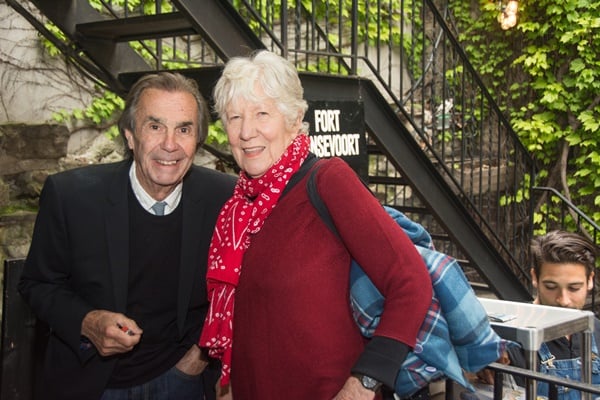
A true Renaissance man breaks into fine art.

Eileen Kinsella

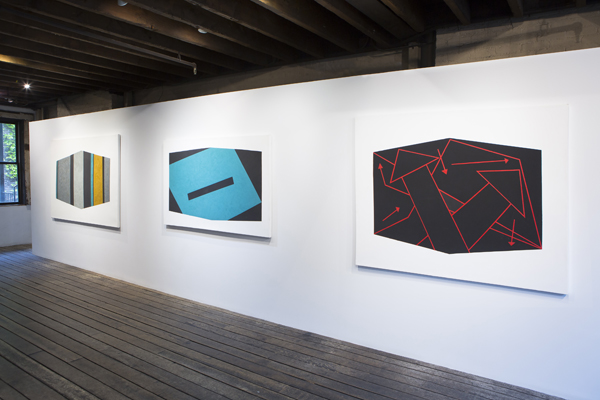
Installation view. Courtesy of the artist.
It’s not every day that art and music stars like Mary Heilmann, Laurie Anderson, Keith Sonnier, and former Talking Heads frontman David Byrne turn up to check out a fellow artist’s show in the Meatpacking District. But then again, jazz musician, composer, photographer, artist, and, yes, Louisiana pecan farmer, Richard “Dickie” Landry is no ordinary man.
His incredibly colorful and adventurous life—and how it led to a surprising solo painting show at the age of 77—is as interesting as the work itself.

Dickie Landry with Mary Heilmann. Image: Courtesy of Fort Gansevoort Gallery.
Landry has primarily been known as a jazz musician who plays saxophone and flute. He came to New York in the late 1960s and connected with his friend and fellow Louisianian, performance artist Keith Sonnier.
“I started meeting a lot of artists and helped them make their pieces and collaborated with them,” said Landry in a telephone interview from his home in Louisiana. He ticked off names including Gordon Matta Clark, Nancy Graves, Joan Jonas, and Richard Serra, to name a few. He also borrowed a camera from a friend and began photographing and documenting their various processes for the next decade.
That material has formed the basis for a book and traveling exhibitions of photographs that have been seen in spaces ranging from Laramie, Wyoming, to Cologne. Landry’s photos were first shown at Leo Castelli Gallery in 1975, and he’s been creating work ever since.
Fort Gansevoort Gallery owner Adam Shopkorn connected with Landry after a mutual friend who was making a music documentary caught sight of his paintings and was intrigued. Shopkorn visited Landry in Lafayette, Louisiana, and they quickly decided to do a show. Spread over three floors in the gallery, it features drawings that Landry made in the mid-1970s and paintings made 20 years later, starting around 1994.
The show runs through June 25 at the Meatpacking District space, which has its own intriguing backstory. It’s a beautiful multi-level townhouse that had a nine-year stint as a restaurant called 5 Ninth—that was shuttered a few years ago and sat empty before Shopkorn negotiated a multi-year lease.
Now it’s a multi-purpose exhibition venue that has its own barbecue pit out back that supplies a take-out service for a few days each week, run by a chef friend of Shopkorn’s. Landry told us that, being from Louisiana, he appreciated showing in a space with some flavor, as opposed to a pristine white cube.
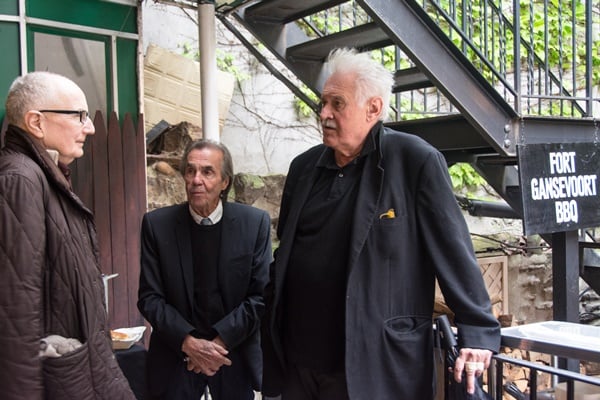
(L to R): Musician Jon Gibson, Dickie Landry, Keith Sonnier. Image: Courtesy of Fort Gansevoort Gallery.
Landry told artnet News he didn’t start painting until 1994 “when I took painting classes in Florida at a friend’s studio. What I painted I immediately threw it in the trash after I was finished with it.”
After more experimentation though he gained some confidence. “The idea for the paintings came from old video screens from the 1960s,” said Landry. “If you remember, they were rounded at the top and rounded at the bottom. I just squared the top and bottom off and then it turns the image into a cube. If you stare at the paintings for a while, they turn into cubes. It’s called axonometric perception. Architects use it for 3D renderings.”
He contrasts playing music with creating paintings, saying: “It’s a turn-on. With music you play and its gone. But with paintings and photographs, there is something on the wall which is tangible. That really excited me.”
For all of Landry’s numerous artist friends who know him as a musician and photographer, the paintings were a welcome revelation. “All my friends in New York had never seen my painting or even knew that I painted,” said Landry. “It was a shock and surprise to everybody. I found it very comforting that they really liked the painting.”
Landry’s list of anecdotes and encounters with fellow artists is as endless as it is fascinating. He recounted how he had found work as a plumber but when Joan Jonas offered him money in exchange for photographs he had taken of one of her performances, he quickly decided snapping photos was the more appealing option for income for a struggling musician.
In 1969, he met Philip Glass, who he wound up collaborating with for the next 11 years as a founding member of the Philip Glass ensemble. He went on tour with the group, and worked on the seminal opera by Glass and Robert Wilson, “Einstein on the Beach.”
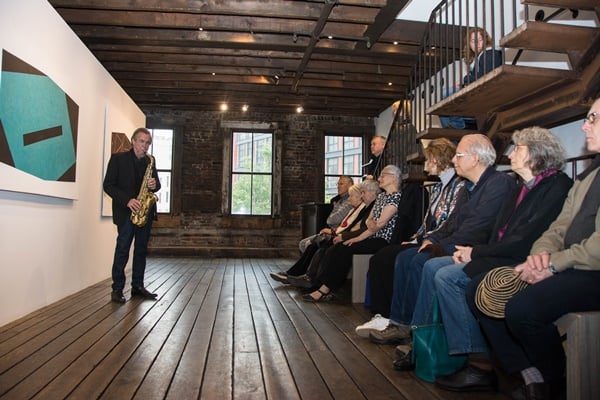
Dickie Landry performs in front of his paintings at Fort Gansevoort Gallery. Image: Courtesy of Fort Gansevoort Gallery.
At the time Landry met Glass, the composer was not yet the world-renowned figure he is today. But as Landry recounts, what caught his attention was a Glass houseguest at the time, a frequently homeless, blind poet and musician who for years hung around Sixth Avenue near Carnegie Hall, dressed like a Viking, and went by the name “Moondog.”
“When I was six years old,” said Landry, “we got electricity on the farm [in Cecilia, Louisiana] and my father got a radio. We used to listen to the heavyweight fights live from Madison Square Garden, and after the fights this man Moondog with a raspy voice came on, saying ‘Live from the streets of New York, jazz with Moondog.’ He was my first underground hero. So when Philip Glass told me, ‘I have Moondog living with me’ I thought ‘I better pay attention to who Philip Glass is if he knows Moondog.”
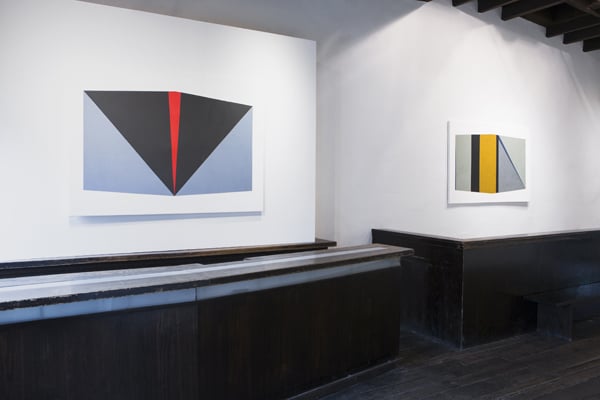
Installation view. Courtesy of the artist.
Several years ago, during a major John Chamberlain retrospective at the Guggenheim Museum, Landry gave a solo saxophone concert that involved him strolling around the rotunda and playing. He has also given several solo saxophone performances for friends at the current Fort Gansevoort Gallery show.
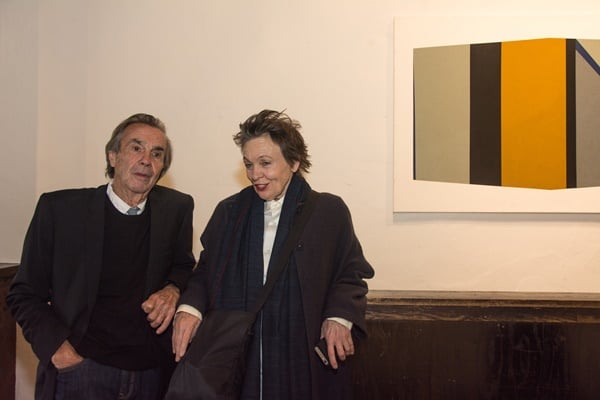
Dickie Landry with Laurie Anderson. Image: Courtesy of Fort Gansevoort Gallery.
Though there are no immediate plans for another show, Landry says he is going back into the studio to make more paintings and is also “resurrecting his dark room,” so he can make more silver gelatin prints of the photos he took in his previous life in New York. He also continues to oversee 80 acres of land that constitute his pecan farm.
Asked why he waited so long to show his paintings, he laughs and says: “Well it’s simple. Nobody offered me a show.” He adds: “A couple of people had the chance but they didn’t come look at the paintings. Adam took the time to come here and sit down in my studio. He said ‘Okay, let’s have a show.’ I said, ‘Great!'”